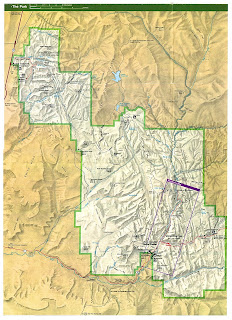
ZION NATIONAL PARK
Zion National Park is a short two hour journey of 83 miles traveling south west of Bryce Canyon along Highway 89, until we reach Springdale, Utah. Zion National Park covers 229 square miles of protected area, with a thriving wildlife and large diversity of plant species inhabiting the area, Zion National Park is a very diverse and interesting place for tourists to visit.
People have inhabited Zion for over 12,000 years, originally inhabited by the Anasazi, whom moved on due to environmental conditions. In the 1860's, after an initial visit to Zion by John Weasley Powell, Mormon pioneers began to settle in the area. With the Mormons actually naming Zion; meaning 'place of quiet sanctuary'. Formed initially through uplift and undercutting of the Virgin river, Zion began to form the outstanding features that can be seen today; rock formations, the canyon and the plateaus. In 1909 Zion Park became a National Monument, and just ten years later, in 1919 it was granted National Park status.
MISSION STATEMENT FOR NATIONAL PARKS
“…To conserve the scenery and the natural and historic objects and the wild life therein and to provide for the enjoyment of the same in such manner and by such means as will leave them unimpaired for the enjoyment of future generations...”
An act of congress to create the national park service, Aug 1916
Zion National Park maintains the mission statement set out by congress in a variety of ways; most importantly it is one of the leading National Parks for sustainable tourism. Zion has strategies in place with almost all activites relating to the site, making every effort to limit environmental and cultural impacts of tourism. Some of these strategies include: a shuttle bus system, recylcing facilities, water bottle filling stations and the use of Trombe (including solar panels) to power the lodge.
The range of activities on offer at Zion appeal to a range of tourists; eco-tourists, environmental tourists, geo-tourists... There is something on offer for everyone. The physical features of the area which have been formed over thousands of years (initially from undercutting, then erosion by the Virgin river) offer a view into the entire landscape of the south-west. The layer of rock visible in this area is the Navajo sandstone, which is the youngest layer visible of the Grand Canyon. However the landscape is everchanging; In 1994 there was a landslide resulting in not only a section of the road to Zion being cut off and the park being shut for six weeks but it also led to a dramatic change to the landscape. Evidence of this can still be seen in the form of large boulders on the river edge, however much of the landslide has been since eroded and transported downstream by the Virgin river.
There are a number of trailsnot only leading to visually awesome scernaries, but also interesting geological formations, at a range of fitness levels. By following the Emmerald trail, you reach a number of naturally formed pools, each being inputted by a waterfall falling pituresquely of the local rock formation.
One of the key activites that Zion offers, like all other national parks, is the opportunity to be educated about the sourrounding environment. The junior ranger scheme offers the chance for young (and old) to learn about the park, and how they can help to retain the area and limit their impact. As part of this, the museum offers the opportunity to learn about the geology and history of the area. Rangers are also regulary on hand to help assit in further understanding of the area.
Hannah: "In my personal opinion, Zion was one of my favourite places visited on this trip so far. Even though the Grand Canyon was awesome, there was something untouchable about it. At Zion, the trails allowed you to access all reaches of the park, experiencing a variety of different features (the presence of water and vegetation was a nice change!). By going along the Emmerald pool trail, we were able to witness the beauty of a waterfall cascading into a pool of water tucked away up a trail. The way it was hidden yet accessible gave it a sense of a very magical place, different to its other surroundings with a beach, pool and rocks."
Josh: "I have been looking forward to visiting Zion all throughout this trip and it did not disappoint! You get a completly different perspective to other National Parks; whereas in the Grand Canyon and Arches you are looking down into the park, Zion lets you into it's secrets. It lets you feel, smell and hear things you couldn't in many other parks. After the desolation of the desert in the surounding area the vegetation makes a beautiful change. The scenic drive into Zion adds to the experience, when half way down into the park a view of the road winding through mountains gives you a sense of energy and inspiration."
Aaron: We believe that Zion was one of the top National Parks to go. It offered outstanding scenery that would literally take your breathe away. What makes Zion so spectacular was the distribution of trees in the surrounding area of the trail. The Emerald Trail in particular was incredibly impressive in that it offered a new water based pool at each stage of the walk. As you ascended up the route the pools grew and were more outstanding than the previous. Once you reach the top pool you are met with incredible views and scenery near and far. At the top there is a monumental view of a waterfall above you when standing on a beach. Despite it being a strenuous walk it was definitely worth it!!
No comments:
Post a Comment